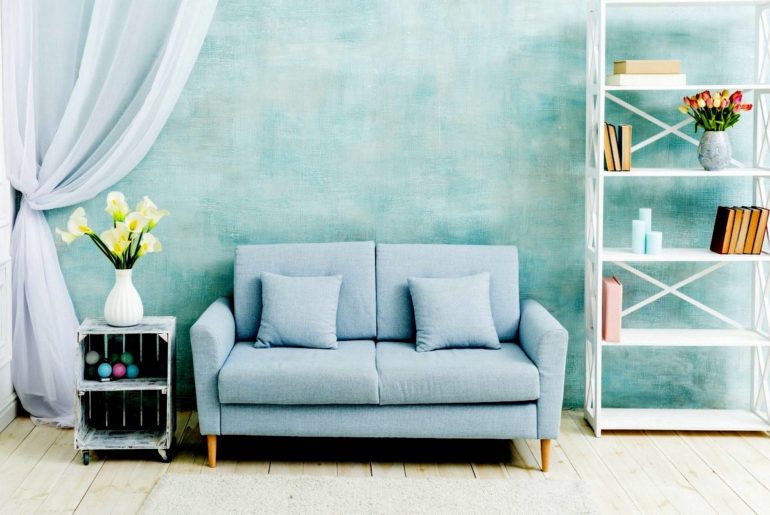Some people claim they work well in a high-stress environment. I’m not one of them.
My productivity is highest when I’m fully relaxed. With inspiring goals, I still feel a positive urging to get my work done — but the pressure to work stems from passion instead of fear.
Last year, I made changes to my home office to better relaxify it (I know “relaxify” isn’t a word, but it should be). I enjoy being in my workspace, and I can work productively for many hours without feeling like I’ve lost my humanity.
When considering changes to where you work, here’s rule #1: If it feels right to you, it is right. That rule is primary; my specific suggestions are secondary.
With that in mind, here are 10 suggestions for creating a more relaxing workspace:
1. Make your workspace look attractive to you.
 When I walk through a typical corporate office building, I see the most dreadfully sterile workspaces. It doesn’t look remotely human. Do people get hired to work there… or assimilated?
When I walk through a typical corporate office building, I see the most dreadfully sterile workspaces. It doesn’t look remotely human. Do people get hired to work there… or assimilated?
Must a professional workspace be a sterile sea of beige and gray? Remember that where you work, you also live. Given the amount of time you’ll be living in your workspace over the course of your lifetime, it makes sense to add some visual appeal.
The first time you see your work area each day, you should feel good about it. It should be attractive to you. Really it should be your favorite place in the entire building, house, or campus.
If you’re in your workspace right now, please step outside for a minute, and then re-enter it while paying close attention to your sense impressions. What’s the very first emotional response you can detect? Do you feel stressed? Overwhelmed? Bored? Apathetic? Focused? Peaceful? Is this an emotion you experience often while working?
Now choose the emotion you want to feel, and experiment with different visual elements to see how they alter your feelings.
Try new furniture, photos, posters, mirrors, flowers, knick knacks, toys, statues, rugs, artwork, crystals, etc. If you have the necessary control, you can also tweak the lighting in your workspace to create the right type of mood. I know a programmer who works in a completely dark room with no windows, and he loves it.
2. Clear out the clutter.
One look at a cluttered workspace, and you get a sense that the person working there is stressed, overwhelmed, and disorganized.
Years ago, I read about a study that concluded most managers will not promote a person with a messy workspace into a position of responsibility. It’s assumed that if you can’t organize your physical environment, you’re probably incompetent to a certain degree and can’t be trusted… and if layoffs happen, you can imagine who the most obvious targets are.
But even more critical is the effect a cluttered workspace has on your focus. It’s difficult to feel centered when you’re surrounded by unfinished tasks that constantly remind you of what you haven’t done yet.
Ideally, the only paper items on your desk should be directly related to the current task at hand. Store everything else in drawers, shelves, or cabinets. Many people notice a dramatic improvement to their productivity when they try this.
For how-to tips on organizing your workspace, be sure to read Smart tips to reduce clutter & organize your home office.
3. Add plants.
Plants are a wonderful way to add life to a lifeless workspace. Use only living, oxygen-generating plants, not lifeless fake ones. Water them as needed to keep them healthy. Over time you’ll find that your plants begin to resonate with you and become a reflection of you. Dying plants = dead career. Fake plants = appears successful, but empty on the inside. Healthy plants = healthy career. Lots of plants = abundance. Bring yourself back to nature by adding some plants to your workspace, and you’ll find yourself enjoying the environment much more.
I currently have three plants in my office, and I’ll soon add more. Two are lucky bamboo plants. Are they really lucky? Since I bought them last year, the income I receive from this site has increased by about a factor of 100, so who knows? I added a small mirror behind them as well, which doubles their visual presence without taking up extra space. Maybe that doubles my luck, too.
4. Make it smell good.
Australian dentist Paddy Lund has his staff bake fresh muffins for his patients daily. Think about how a dentist’s office usually smells — then imagine walking into one that smells of blueberry muffins. Along with other changes, this reportedly helped Lund increase his income by a factor of ten. I’m not suggesting you add a Holly Hobby Easy Bake Oven to your workspace, but there are plenty of practical ways to make it smell better than cleaning supplies.
A while back, I read that certain scents have a measurable effect on productivity. If I recall correctly, lemon and lavender produced the most significant positive results.
Personally, I love scented candles, especially the 3″x6″ pillars. They not only make my office smell good, but the colorful candles and decorative candle holders add visual appeal as well. My favorites aromas are vanilla and lemon. I have almost a dozen scented candles in my office at any one time. I find it worthwhile to pay for good quality candles. I’m no candle expert, but I’ve noticed that the cheapest ones tend to burn unevenly, become terribly misshapen as they burn down, and don’t produce a very rich aroma.
Occasionally I’ll burn some Tahitian vanilla incense, but I use that very sparingly and wouldn’t recommend it in a corporate environment because you’ll stink up the whole building. I burn it right next to an open window, which dilutes the scent and keeps the room from becoming smoky.
If you don’t like candles, there are other options for improving the smell of your office. You can get a diffuser and fill it with essential oil, add some potpourri, or even try sliced lemons. Be careful when considering chemical air fresheners though, as there are reports they can pose health risks.
5. Play relaxing music.
Experiment with different types of music to see what effect they have on your stress level and productivity. Use headphones if you need to keep from disturbing others.
I prefer total silence when I do certain types of work, but for everyday tasks I like listening to music. (My favorite streams are Vocal Trance and New Age.)
6. Get a decent chair.
Most likely you’ll use your chair more than any other object in your workspace, so consider investing in a good one. Today there’s an assortment of oddities you can sit on, including knee chairs, balls, and more. Head to an office supply store and find something that suits you. If your company won’t get you a decent chair, then consider buying your own.
I don’t own a super-expensive chair (I think it was $200 originally), but it works for me. It keeps my spine straight, and I can sit for hours without pain or discomfort. I tested dozens of different chairs before picking this one. It’s about 10 years old now though, so this would probably be a good time for me to take another look to see if I can find an even better one. I’ve heard really good things about the Aeron desk chairs. On the other hand, it might be more fun to upgrade to a throne.
7. Add a portable fan.
Even with good air conditioning, you might have periods where you just want to feel a little cooler, or maybe you’d like a bit of air circulation. Use a small portable fan to keep your comfort level right where you want it to be.
Today’s high in Las Vegas is 105 F, and later this week it’s supposed to hit 110. Mid-summer temperatures can exceed 120 degrees. Even with the air conditioning on, it can still get a little warm in my home office during the summer. A portable fan is a nice addition to my workspace. The Vornado fans are really good. They’re a little more expensive but well worth it — they run quiet and circulate the air nicely.
8. Add a fountain.
If you find the sounds of running water soothing, consider adding a small fountain to your workspace. You can get a basic one for under $20.
Last year, I added an illuminated rock garden fountain to the corner of my home office. I plugged the power supply into the same power base I use for my PC equipment, so I can simply flip a switch in front of me to turn it on. I probably run it about eight hours a day on average, and I add water about once every three days. When I hear the fountain running low, I’m reminded to water my plants too.
9. Personalize your space.
Does your workspace look like an automaton works there, or does it include elements that are uniquely you? Remember that your workspace is your living space for much of your day, so make it livable and not just workable. A good way to accomplish this is by adding items that hold emotional significance for you.
Photographs are an easy way to personalize your space. I have some typical family photos in my office and the requisite wedding picture, but there’s one particular photo from when my wife and I first met that was taken by my (now deceased) grandfather that’ very special to me. I like being able to see it when I work. It also reminds me that I’m not alone — my wife and I are sharing a wonderful path together, and I’ve seen plenty of signs that my grandfather is watching over us.
10. Establish uninterruptible periods.
Negotiate a period of time each day where you turn off all outside communication, and encase yourself in a cocoon of concentration. Put up a “Do Not Disturb” sign, turn off your phone, disable your instant messenger, and don’t check email either. Use this time to work on the tasks that would cause you the greatest stress or which require your utmost concentration. It’s easier to relax and focus when you know you won’t be interrupted.
Some jobs obviously require more solo concentration time than others. A computer programmer may need a lot, while a receptionist may need virtually none. Determine how much you need to be productive, and do whatever is necessary to get it.
When I really need to concentrate, I usually lock my office door. My family sometimes objects to these communication blackouts, but with two kids at home on summer vacation now, I find it necessary to enforce some boundaries in order to get my work done. I’m not particularly friendly or compassionate when I get interrupted while writing, so this is largely for their own safety.
Now go do it!
Take a moment to survey your workspace and jot down a few changes you’d like to make. How can you make your workspace even more relaxing, livable, and attractive? If cash is tight, set a budget for how much you’d like to spend on relaxifying your workspace. Maybe you can even get your employer to pay for some of it, especially if it’s likely to boost your productivity.
What if your employer rejects the changes you’d like to make? Some changes are certainly negotiable because of their side effects. Your coworkers may not appreciate the scent of jasmine wafting through their workspaces. But if your employer is downright ogre-like and won’t permit you a plant or a family photo, well… I’d recommend getting a new employer. Your work should support your preferred lifestyle, not squash it.
Think about the most relaxing places you know of. What is it about those places that makes you feel good? What are the sights, sounds, and smells? How can you modify your workspace to create a similar feel? You might not be able to duplicate the feeling perfectly, but you can always get close.
If you don’t have time for a complete workspace makeover, then just make one little change each week. Add a photo. Buy a plant. Clean up the junk pile. Relaxify and enjoy.
This information was originally published on June 21, 2006







